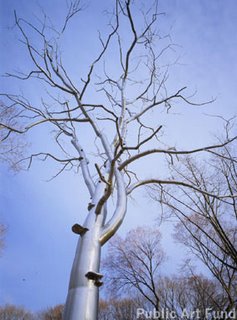Last week there was a geosciences convention at the
Moscone Center, a large conference center just a block from Crown Point Press. Among the conferees was a geophysicist who, in 2002, had been on the same trip to the North Pole by

Russian nuclear-powered icebreaker as Kathan Brown. (The trip would later inspired Kathan’s lovely, eponymous
book, published by Crown Point in 2004.) Since he knew Kathan, the geophysicist stopped by
to say hello and to see our current exhibition, which includes prints by
John Chiara. I was here at the front desk when he emerged from the gallery, waving his arms and talking a mile a minute. He was so excited he’d gotten completely disoriented, and forgotten which way the exit was! While I retrieved his bags and jacket for him, he followed me through the office telling me what he’d loved so much about the work.
John Chiara, 24th at Carolina (left variation), 2006. Photogravure on gampi paper chine colle. Paper size: 32-3/4 x 27-3/4"; image size: 23-1/2 x 19-3/4". Edition 15. Printed by Dena Schuckit.
“It’s a sycamore tree,” the geophysicist said, referring to the foreground of Chiara’s beautiful San Francisco landscapes. The scientist knew a lot about sycamore trees. Did you know that the word sycamore doesn’t refer to a specific tree, but is just a general word that refers to a type of tree? That there is in fact a sycamore that grows figs? That the first British-designed helicopter to successfully fly was called the Bristol Sycamore? He told me that in their natural habitats sycamores require a lot of water, and so often grow in the rich soil near rivers, streams or lakes. I supposed this made Chiara’s chosen tree particularly strong, as it stands far from an underground water source, on the top of Potrero Hill.
This reminded him of another, stronger sycamore. “Do you know about the fake sycamore in Central Park, in New York?” he asked. A fake sycamore? “Sure, I used to walk by it on my way to work,” he said. “It was made out of steel. It was beautiful. But the ends of its branches tapered off into points, and looking up at it, I always half-expected a squirrel to jump into it and get skewered.”
Roxy Paine, Bluff, 2002. Stainless steel. The Whitney Biennial in Central Park, March 7, 2002 - June 30, 2002. The Mall in Central Park. Photo courtesy The Public Art Fund.
The tree’s name was Bluff. It was constructed by the artist Roxy Paine and commissioned by the New York Public Art Fund in 2002. The website for Bluff reads, "Roxy Paine's Bluff was a fifty-foot high tree made of brilliantly stainless steel. Bluff's heavy industrial plates formed a two-foot-wide trunk that supported more than 5000 pounds of cantilevered branches, welded together from 24 different diameters of steel pipes and rods. Its gleaming frame remained unchanged as its environment shifted from winter into spring. By announcing its grand manmade artifice rather than attempting to blend in with the surrounding real plants and trees, Bluff was a cunning reminder that Central Park is itself an artificial sanctuary, a product of city planners as much as Mother Nature."
I recently moved to a neighborhood 5 miles from Crown Point Press, San Francisco’s Sunset district. Most days, I bike to work through Golden Gate Park, a spacious, lush public park born in the 1860’s in response to New York’s Central Park, which was also taking shape at that time. Blue Gum Eucalyptus was imported from Australia and planted alongside native Monterey Pines and Monterey Cypresses to thicken the 60,000 tree forest that holds together the California sand dunes underfoot. To keep it alive and thriving, processed and recycled water, called effluent, is pumped in from the city’s sewage treatment plant. The park is such a beautiful success that John McClaren, the proud gardener who saw its construction through to completion, lived in Golden Gate until he was 90 years old. McClaren died just a decade before the introduction of artificial detergents in the 1950’s would cause billowing piles of foam to form on the creeks that connected its artificial lakes. The foam blew onto the paths and roads of the park, blocking traffic and killing wildlife. Talk about an “artificial sanctuary” — the toxic overflow must have been more  like a sanctuary of the artificial.
like a sanctuary of the artificial.
Tom Marioni, New Growth, 2006. Color drypoint with flat bite etching. Paper size: 22 x 20-1/2"; image size: 13 x 12-1/2". Edition 20. Printed by Dena Schuckit.
Learning about the construction of the park made me think of the Crown Point gallery itself as a kind of 'sanctuary of the artificial.' Here we have two artists, John Chiara and Tom Marioni, who have each created their own series of conceptual 'landscapes'. Critic Thomas McEvilly has written of Marioni's works that they "demystify, diminish, and bring down to earth the solemnity of the sublime." Because the artists have created what they depict (Chiara moved his hand in front of the lens of his camera to get the exposure he wanted; for New Growth, pictured at left, Marioni accumulated visceral dig after dig in his copper plate), their landscapes, though artificial, are more human than landscape itself.
- Rachel Lyon
 Russian nuclear-powered icebreaker as Kathan Brown. (The trip would later inspired Kathan’s lovely, eponymous book, published by Crown Point in 2004.) Since he knew Kathan, the geophysicist stopped by
Russian nuclear-powered icebreaker as Kathan Brown. (The trip would later inspired Kathan’s lovely, eponymous book, published by Crown Point in 2004.) Since he knew Kathan, the geophysicist stopped by 
 like a sanctuary of the artificial.
like a sanctuary of the artificial.
0 Comments:
Post a Comment
<< Home